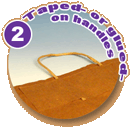Stuff that works
Packaging Bag-handle types
How do they put handles on shopping bags?
Collect an assortment of shopping bags. Look carefully at how the handles were constructed. How many different types of handles are there? How would you describe each type? Based on this information, sort your bags according to the way their handles are made.
This is what we found when we tried out this activity. We sorted the bags into six basic categories:

1. Found on the cheapest of plastic bags, these consist of oval-shaped slots cut directly into the two sides of the bag.

2. The most common paper shopping bags are of this type. Each handle is made of a separate piece of paper, which is added to the body of the bag, and held in place by a piece of tape or by a glued paper strip.

3. These are found on glossy gift bags and fancy paper bags from upscale stores. Each handle consists of a piece of string, slipped through a pair of holes and knotted to keep it in place.

4. In this type, the handles are made of the same kind of flexible plastic as the rest of the bag. The handles are attached by clamping them to the bag, and heating them briefly, leaving a slightly deformed square or rectangle where the heat was applied.

5. Here, the bag is made of a thin flexible plastic, and the handles are made of a thicker, more rigid plastic material. Each handle is fastened by inserting tabs through the bag to engage in slots on the other side. Sometimes these handles extend across the entire top of the bag; more often they are just upside-down U’s, clipped at both ends.

6. Shoe stores and athletic supply stores often use this kind of bag. The handle consists of a single piece of string, held by a hem around the top of the bag, with an opening for the string to emerge and be held.
Focusing questions: As you look through and sort through your bags, look for any differences between your categories and ours. More specifically, have we left out any handle types? Should some of our categories be further subdivided?
What’s next? Now that you have completed this activity, you are ready for How Shopping Bags Fail.